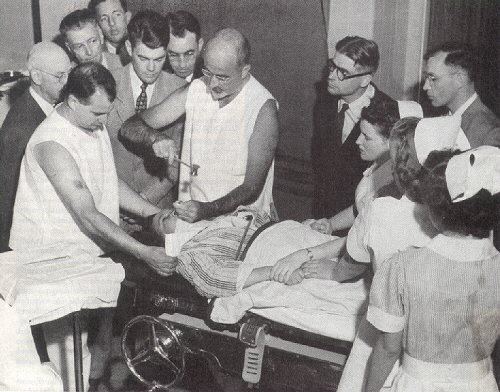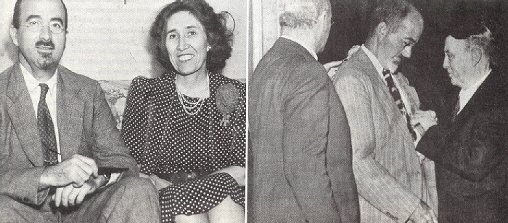
Mrs. Hammatt's last words before surgery were, 'Who is that man?... What's he going to do to me? Tell him to go away...' followed by a scream. |
||
| disorders caused mental illness. Now we live in
an era in which a biological and brain-centered view of mental illness reigns supreme.
But do today's neuroscientists celebrate Freeman as a pioneer, far ahead of his time in his focus on the brain in treating psychiatric disorders? Far from it. Researchers investigating new methods of surgically treating the brain for mental illnesses find his legacy a hindrance to the public's understanding and acceptance of their research. Why, 34 years after his final lobotomy, does Walter Freeman continue to cast a shadow over psychiatric surgery? The answer lies in the complex tangle of Freeman's personality and motivations, and in the public's fear of past abuses. WHEN FREEMAN ARRIVED in Washington in 1924 to direct the laboratories at St. Elizabeths Hospital - one of the nation's preeminent institutions for the insane - he carried with him more baggage than medical textbooks and instruments. He also shouldered a load of high expectations, courtesy of his family. Born and reared in Philadelphia, Freeman belonged to a prominent and hard-working medical clan. His maternal grandfather, William W. Keen, served as a surgeon during the Civil War, removed a tumor from the jaw of President Grover Cleveland, experimented with an early form of cardiopulmonary resuscitation, and was a president of the American Medical Association. Freeman's father was an otolaryngologist with a practice of modest attainments. Freeman himself attended Yale and the University of Pennsylvania School of Medicine before studying neurology and psychiatry in Europe. Initially, he regarded mental hospitals with what he called in his unpublished memoirs "a rather weird mixture of fear, disgust, and shame." These feelings soon were transformed into indignation: "I looked around me at the hundreds of patients and thought what a waste of manpower and womanpower." Freeman thought the idleness and confinement of vast numbers of patients a great social tragedy and he wanted to do something about it. He set about - ultimately unsuccessfully - to discover measurable able differences between normal brains and those of schizophrenics. While working at St. Elizabeths, Freeman opened a private practice and joined the medical faculty of George Washington University as a professor of neurology. By the mid-1930s he had introduced several new therapies for mental patients at GW Hospital: insulin shock therapy, metrazol shock therapy and electroconvulsive therapy. All of these treatments were intended to fight psychiatric disease by subjecting patients to chemicals or jolts of electricity that might disrupt unhealthy neural activity in the brain. It's easy to imagine Freeman - his high forehead, steel-rimmed glasses and goatee making him look the part of the consummate 1930s mental doctor - convincing seriously ill patients and their desperate families that these experimental treatments held the only hope for recovery. For many Americans with psychiatric diseases, hospitals could offer little else except the agonies of cold-water therapy and long-term storage in facilities that echoed with the Jack El-Hai is a Minneapolis freelance journalist who frequently writes about psychology and medicine. |
screams and moans of the hopeless. In 1935 Freeman caught his first glimpse of yet another treatment that could join his arsenal. At a London conference, he attended a presentation by a Yale researcher on the behavioral effects of surgical damage to the frontal lobes of chimpanzees. The animals became subdued and inactive. Rather impulsively, another conference attendee, a Portuguese neurologist named Egas Moniz, rushed home and began performing similar operations on mentally ill people. Moniz's subsequent reports on these experiments crossed the Atlantic and further intrigued Freeman. To him, the intoxicating thing about psychosurgery - Moniz's coined term for psychiatric surgery - was its potential to sever the links between the over-excited emotions of an unhealthy thalamus and the behavioral functions of the prefrontal lobes of the brain. If it worked, the destruction of these nerve fibers would prevent the thalamus from poisoning patients' thinking. He absorbed the details of Moniz's work and, with GW neurosurgeon Watts, began figuring out how to adapt the Portuguese physician's techniques. Freeman and Watts used brains from the hospital morgue to practice the coring of sections of the pre-frontal lobes with a leucorome, By the summer Of 1936 they were ready for a live patient: a Mrs. Hammatt from Topeka, Kan. Sixty-three years old and suffering from agitated depression, she came to Washington with her husband, desperate for an improvement to her sleepless and hysteria-filled life. Freeman explained to her that without a lobotomy -the name he and Watts gave for their surgery - she faced an indefinite stay in a mental hospital. She decided to take her chances with this new operation, which was scheduled for September 14,1936. When the day arrived, Mrs. Hammatt tried to change her mind when she found out that her head had to be shaved. Freeman and Watts promised to spare as much of her hair as they could, before forcibly anesthetizing her. Later, Freeman recorded that her last words before surgery were, "Who is that man? What does he want here? What's he going to do to me? Tell him to go away. Oh, I don't want to see him," followed by a scream. Freeman and Watts then performed America's first lobotomy. They drilled six holes into the top of Mrs. Hammatt's skull and inserted a leucotome into each. The two physicians shared the task of lesioning the brain, as they did for all of the approximately 1,000 lobotomies they performed together. They rinsed the openings with saline solution and sutured the wounds. By Freeman's account, Mrs. Hammatt emerged a transformed woman. She felt a great relief of her anxiety. After a hemorrhage scare on the third day of recovery, she was discharged from GW Hospital about a week later. "She survived five years, according to Mr. Hammatt the happiest years of her life," Freeman noted in his autobiography. "As she expressed it, she could go to the theatre and really enjoy the play without thinking what her back hair looked like or whether her shoes pinched." Thus encouraged, Freeman and Watts went on to perform more operations and further refine their technique. They replaced Moniz's coring leucotome with one resembling a butter knife and moved the entry holes to the sides of the skull. They developed a "radical" procedure that made more cuts into the brain. Some patients needed multiple |
|

WALTER FREEMAN, CENTER ABOVE, WORKS A LEUCOTOME UNDER THE EYELID OF A PATIENT - POSSIBLY MOVIE ACTRESS FRANCES FARMER - WHILE DEMONSTRATING HIS TRANS-ORBITAL LOBOTOMY TECHNIQUE AT WESTERN STATE HOSPITAL IN STEILACOOM, WASH., IN 1949; BELOW RIGHT, FREEMAN RECEIVES AN AWARD FROM PORTUGUESE NEUROLOGIST EGAS MONIZ, WHOSE EXPERIMENTS INSPIRED FREEMAN; FREEMAN AND HIS WIFE, MARJORIE, AFTER AN INTERNATIONAL CONFERENCE IN 1939.
